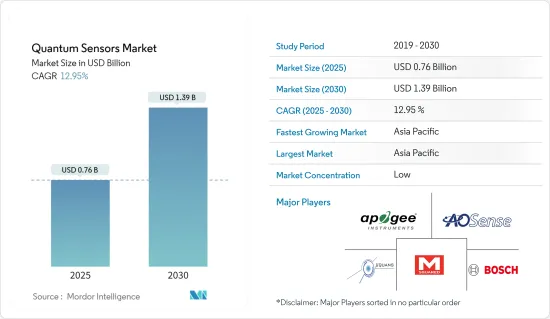Need help finding what you are looking for?
Contact Us
PUBLISHER: Mordor Intelligence | PRODUCT CODE: 1687920

PUBLISHER: Mordor Intelligence | PRODUCT CODE: 1687920
Quantum Sensors - Market Share Analysis, Industry Trends & Statistics, Growth Forecasts (2025 - 2030)
PUBLISHED:
PAGES: 121 Pages
DELIVERY TIME: 2-3 business days
SELECT AN OPTION
The Quantum Sensors Market size is estimated at USD 0.76 billion in 2025, and is expected to reach USD 1.39 billion by 2030, at a CAGR of 12.95% during the forecast period (2025-2030).

Key Highlights
- Government investments in quantum research to gain economic and military advantage have been increasing. The National Strategic Overview for Quantum Information Science released by the United States defined quantum sensing as 'leveraging quantum mechanics to enhance the fundamental accuracy of measurements and enabling new regimes or modalities for sensors and measurement. Such new capabilities could afford clear military advantages and positively influence the market globally.
- Innovation in the quantum sensors industry is being driven by developments in quantum technology, especially in fields like sensing communication and computation.
- For instance, high-resolution imaging is now possible for industrial inspection and medical diagnostic applications because of the advent of quantum-enhanced imaging techniques. Similarly, the use of quantum sensors for secure communication networks is being fueled by advancements in quantum key distribution (QKD) technology.
- Growing research and developmental activities related to quantum technology are expected to provide ample opportunities for market growth in different fields, such as positioning systems, electric and magnetic field sensors, communication technology, microscopy, mineral prospecting, and seismology, along with applications in military, construction industry, and automotive. High credibility and accuracy make this technology accessible across various sectors.
- There is a high level of initial investment required in end-user industries for integrating such sensors in applications such as autonomous driving, improved imaging technologies at short and long distances, medical progress, and enabling detailed underground mapping. The high costs of setting up these systems are concerned with proper installation, design, and fabrication.
Quantum Sensors Market Trends
Oil and Gas Industry to Grow Significantly
- The oil and gas industry faces remarkable challenges as hydrocarbon product exploration, production, and transportation are conducted in ever-more challenging environments. Quantum technologies bring new capabilities to the sector as they are adopted to provide increased safety and security. These range from new forms of gravimeters to discover further oil reserves to fiber optic distributed temperature and strain sensing and optical gas imaging systems to detect and locate gas leaks.
- Furthermore, to explore developing chemistry applications using quantum computing, Japanese chemical companies JSR and Mitsubishi Chemical joined a quantum computing ecosystem, the IBM Q Hub, at Keio University in Japan. Both companies expect to leverage the Hub's collaborative partnership with Fortune 500 companies, academic institutions, national research labs, and access to 20-qubit and 50-qubit quantum computers to investigate developing quantum computing solutions specific to their businesses.
Asia-Pacific is Expected to Register Major Growth
Quantum Sensors Market Overview
Additional Benefits:
Product Code: 66891
TABLE OF CONTENTS
1 INTRODUCTION
- 1.1 Study Assumptions and Market Definition
- 1.2 Scope of the Study
2 RESEARCH METHODOLOGY
3 EXECUTIVE SUMMARY
4 MARKET INSIGHTS
- 4.1 Market Overview
- 4.2 Industry Value Chain Analysis
- 4.3 Industry Attractiveness - Porter's Five Forces Analysis
- 4.3.1 Bargaining Power of Suppliers
5 MARKET DYNAMICS
6 MARKET SEGMENTATION
7 COMPETITIVE LANDSCAPE
8 INVESTMENT ANALYSIS
9 FUTURE OF THE MARKET
Have a question?


SELECT AN OPTION
Have a question?


Questions? Please give us a call or visit the contact form.
